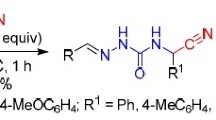Abstract
By the reaction of 15 with 3-halohydantoins (4–14) in N,N-dimethylformamide, which were prepared from corresponding hydantoins, 3-bromo-5,5-dimethylhydantoin was found to be the most convenient reagent for halolactonization reaction.
Similar content being viewed by others
Literature Cited
House, H.O.,Modern Synthetic Reactions 2nd ed., W.A. Benjamin Inc., Meleno Park, California, 441 pp. (1972).
Dowle, M.D. and Davies, D.I., Synthesis and Synthetic Utility of halolactones.Chem. Soc. Rev.,8, 171(1979) and references cited therein.
a) Bougault, M.J., Action De L'acide Hypoiodeux Naissant Sur Les Acides Non Satures. Lactones iodees.Ann. Chim. Phys. 14, 145(1908) and references cited therein. b)idem Bougault, M.J., Action De L'acide Hypoiodeux Naissant Sur Les Acides Non Satures.ibid. Ann. Chim. Phys.,15, 296(1908).
a) Corey, E.J. and Hase, T., Studies on the Total Synthesis of Rifamycin. Highly Stereoselective Synthesis of Intermediates for Construction of the C(15) to C(29) chain.Tetra. Lett.,1979, 335. b) Terashima, S. and Jew, S., Asymmetric Halolactonization Reaction: A Highly Efficient Synthesis of Optically Active α-Hydroxy Acids from α,β-Unsaturated acids.Tetra. Lett.,1977, 1005. c) Jew, S., Terashima, S., and Koga, K., Asymmetric Halolactonization-Asymmetric Synthesis of Optically active α,α-I' Disubstituted-α-Hydroxy Acids from α,β-Un saturated Acids by the use of Halolactonization Reaction I.Tetrahedron,35, 2337 (1979). d) Cambie, R.C., Hayward, R.C., Roberts, J.L., Rutledge, P.S., lodolactonizations using Thallium (I) Carboxylates.J. Chem. Soc. Perkin I,1974, 1864. e) Bartlett, P.A. and Myerson, J., Highly Stereoselective Synthesis (+)-α-Multistriatin.J. Org. Chem.,44, 1625(1979).
Nicolaou, K.C., Seitz, S.P., Sipio, W.J., and Blount, J.F., Phenylseleno-and Phenylsulfenolactonizations. Two Highly Efficient and Syntheti Useful Cyclization Procedures.J. Am. Chem. Soc.,101, 3884(1979) and references cited therein.
Cook, C., Cho, Y., Jew, S., and Suh, Y., Studies on Novel Haloactonization Using N-Haloimides under Non-aqueous Media(l).Seoul Uni. J. Pharm. Sci.,4, 109(1979).
Cook, C., and Kang, E., Novel Bromolactonization Using N-Bromophthalimide.Arch. Pharm. Res.,4, 137(1981).
a) Oakes, V., Rydon, H.N., and Undheim, K., Polyazanaphthalenes. part VII. Some Derivative of Quinazoline and 1,3,5-Triazanaphthalene.J. Chem. Soc.,1962, 4678. b) Corral, R.A., and Orazi, O.O., Oxidation of Secondary Aromatic Alcohols with N-Bromoamides.Chem. Comm.,1965, 5.
Pizey, S.S.,Synthetic Reagents, vol. I. John Wiely and Sons Inc., New York, 4pp. (1974) and references cited therein.
Vogel, A.I.,Practical Organic Chemistry, 3rd ed., Longmans, Green and Co. Ltd., London, 926pp. (1956).
van Tamelen, E.E., and Shamma, M., Assignment of the Olefinic Position in Unsaturated Acids by Means of the Iodolactonization Reaction.J. Am. Chem. Soc.,76, 2315(1954).
All new compounds give IR, NMR, and/or mass spectral in complete accord with the desired structures.
a) Ishii, Y., Ito, Y., and Kato, S., Synthesis of Hydantoin Derivatives and Halogenation of N-Halohydantoin.Kogyo Kagaku Zasshi. 61, 1254 (1958). b) Orazi, O.O., and Meseri, J., Halogenation with 3-Bromo-5,5-Dimethylhydantoin.Anales. Assoc. Quim. Argen.,37, 192(1949). c) Corral, R.A. and Orazi, O.O., N-Iodohydantoins.ibid.,44, 11(1956). d) Orazi, O.O., Fondovila, M.E., and Corral, R.A., Bromoderivatives of 5, 5-Disubstituted Hydantoins.ibid.,40, 109(1952). e) Waugh, T.D., and Waugh, R.C., N-Brominated Imides and Hydantoins. U.S. pat. 2, 971, 960(1961).
Author information
Authors and Affiliations
Rights and permissions
About this article
Cite this article
Cook, Ch., Jew, Ss. & Chung, Ys. 3-Halohydantoins as halolactonization reagents. Arch. Pharm. Res. 5, 103–106 (1982). https://doi.org/10.1007/BF02856415
Received:
Issue Date:
DOI: https://doi.org/10.1007/BF02856415




